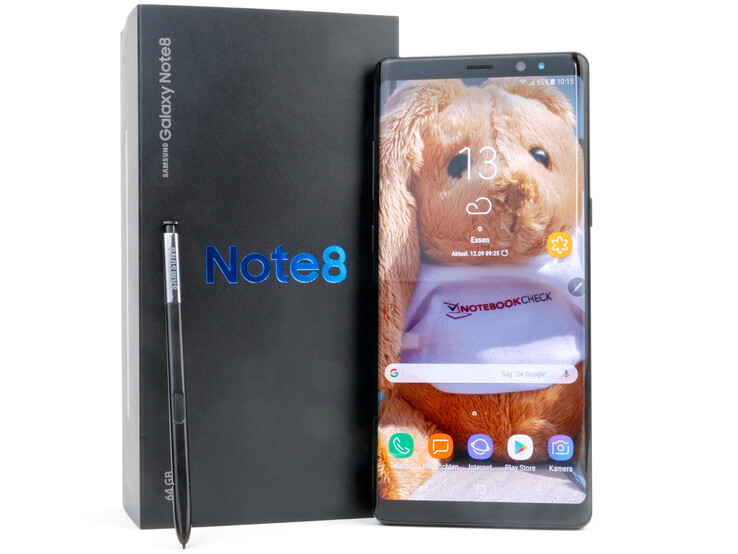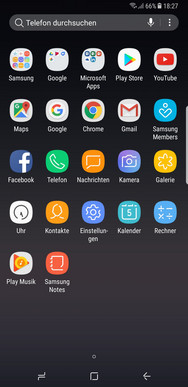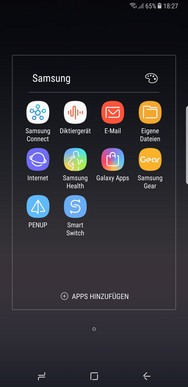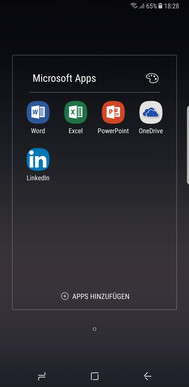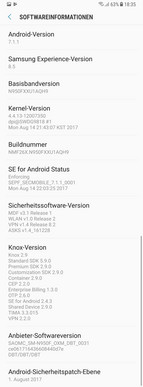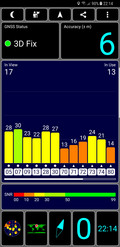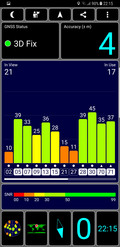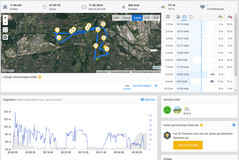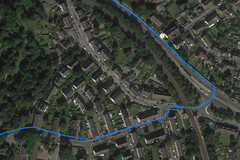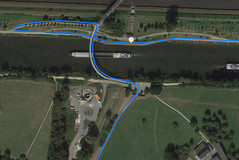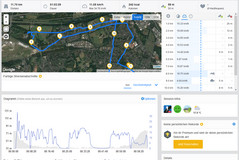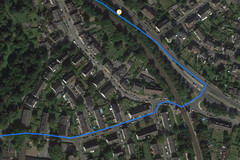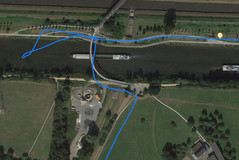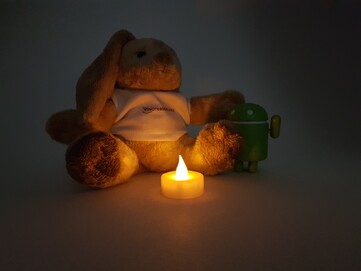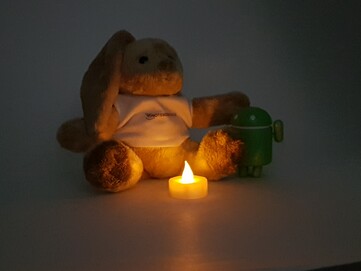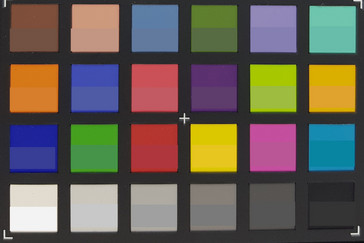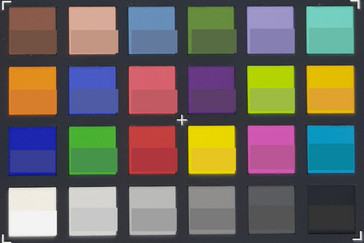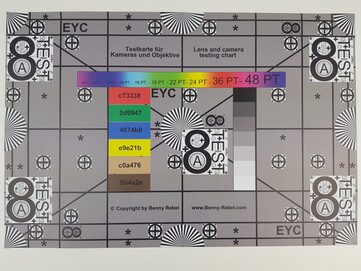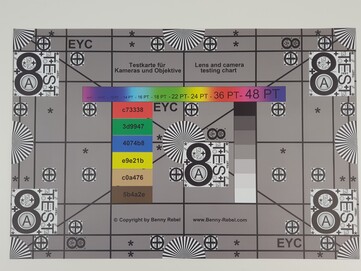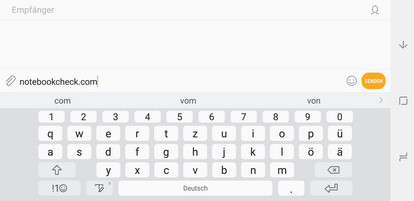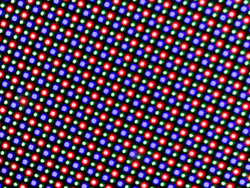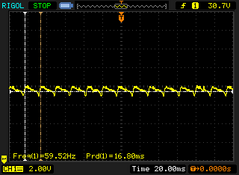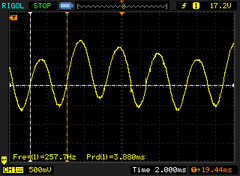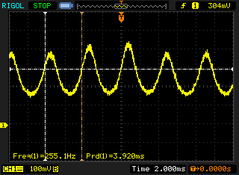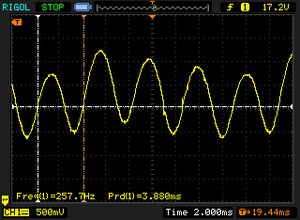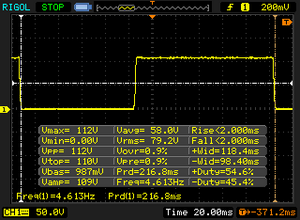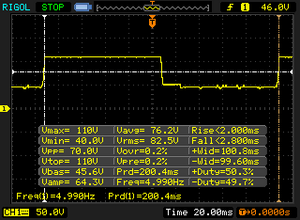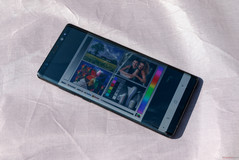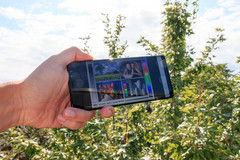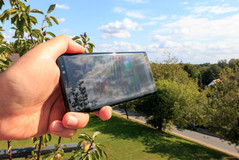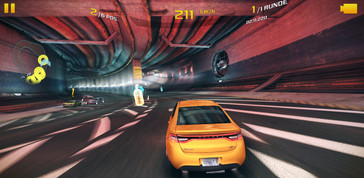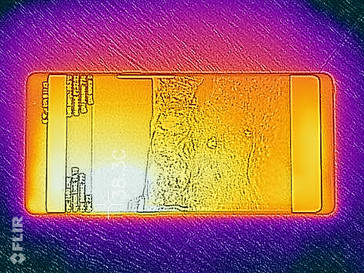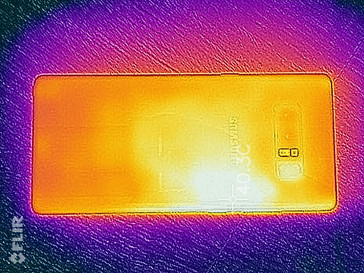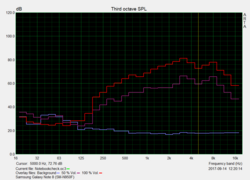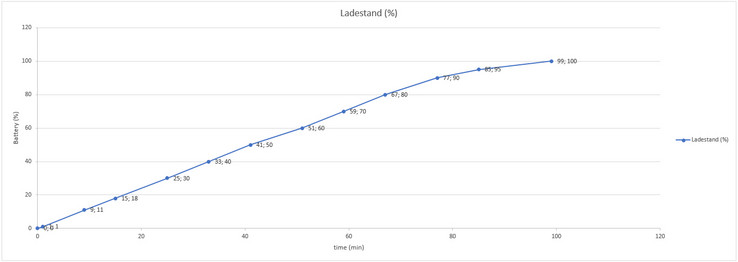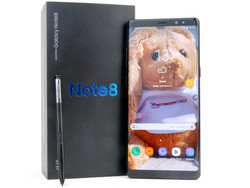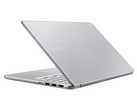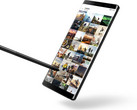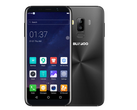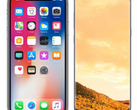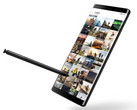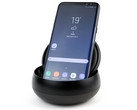Samsung Galaxy Note 8 Smartphone Review
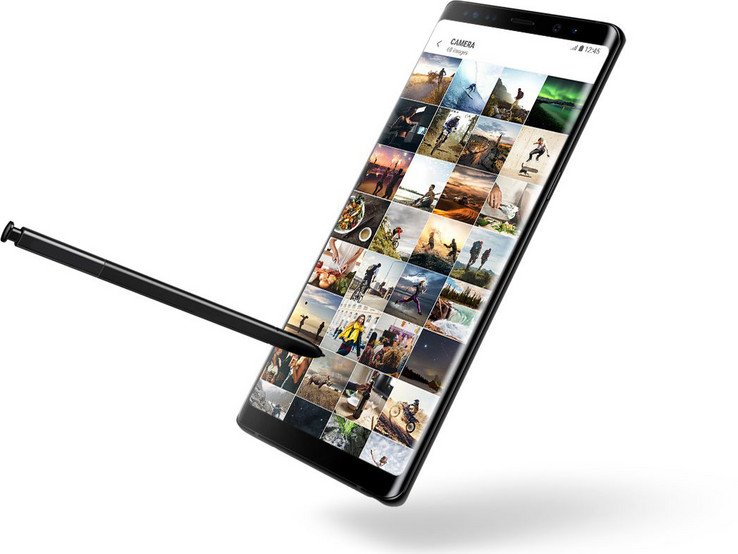
For the original German review, see here.
After the exploding battery disaster of the Galaxy Note 7, Samsung's Galaxy Note 8 (SM-N950F) follows. It now has the duty to cast off the flaw of its predecessor. The biggest innovation is, like in the Galaxy S8 and Galaxy S8+, the new Infinity screen. With a lush size of 6.3 inches, it has the biggest screen surface of all Note models. It also comes with the currently strongest Exynos processor or, depending on the region, the Snapdragon 835. The working memory has increased by 50 percent and now offers 6 GB. Like last year, a 64 GB internal storage is installed and can again be extended via a micro-SD card. The communication modules have also received an update. However, the biggest modifications are found in the camera. Samsung uses a dual-camera in one of its smartphones for the first time. The battery is 200 mAh smaller than that of the predecessor and has 3300 mAh. Even the smaller Galaxy S8+ sports a stronger battery. Find out whether Samsung wants to be on the safe side with the weaker battery and whether the battery life is not affected in the test.
The price is impressive. 999 Euros (~$950) is what the Korean manufacturer demands for its premium model. The Note 7 was sold for approximately 150 Euros less and the Note 5 was even 300 Euros cheaper at market launch. Buyers who order the Note 8 directly from Samsung can also select a dual-SIM variant. Our review sample is a single-SIM model.
The competition is sooner selected based on price range and screen size since no other high-end phablet comes with an integrated stylus. In particular, Huawei's Mate 9, Honor's 8 Pro and LG's V30 want to compete against the giant. Apple offers its biggest model, the iPhone 7 Plus while a genuine business behemoth comes from the Windows lineup: HP's Elite x3. The Galaxy Note 8 also has to compete against all high-end rivals in terms of technology in our test.
Update 1/8/2018: Samsung has released a new update for the Galaxy Note 8. Further details can be found in the software section of this review.
Case
Samsung's Galaxy Note 8 is a real giant with a screen size of 6.3 inches. This is also confirmed when holding it for the first time. It remains pleasantly slim due to the new aspect ratio and is comfortable to hold. However, it weighs a total of 25 grams more than its predecessor. The screen-surface ratio of approximately 83 percent is outstanding.
The metal bezel gives the casing a high-quality impression. The glass on both the front and rear is Corning Gorilla Glass 5 that attracts fingerprints but is also easy to clean. The Galaxy Note 8 absolutely resists pressure and twisting attempts. The gaps are impeccable and tight and do not provide reasons for complaint.
The phablet's card tray is situated on the upper edge and closes flush with the casing. Its latch is also made of aluminum, but the tray itself is plastic. It offers a place for a nano-SIM and a micro-SD in our review sample. A Duos variant that has a hybrid slot is available in Samsung's shop. The user can decide whether s/he wants to insert a second nano-SIM instead of a micro-SD.
The device is again IP68 certified, i.e. it is protected against the ingress of dust and water. According to the standard, this means that it is dust-proof and protected against the ingress of water for an unspecified time when submerged completely into water. Samsung limits the latter to 1.5 meters in fresh water for 30 minutes in the small print. Thus, the correct specification should be IP67.
Samsung's Galaxy Note 8 is available in Midnight Black and Maple Gold in Germany. Orchid Gray and Deepsea Blue are found in other regions. The battery cannot be removed.
Connectivity
It is possible to expand the storage of the Samsung Galaxy Note 8 with an optional microSD card. In theory, all usual SDXC models with up to 2 TB can be used, but only cards with up to 400 GB are available so far. It is not possible to format a microSD as internal storage or move apps there due to performance differences between internal and optional storage.
The USB port has the up-to-date Type-C shape now and supports transfer standard 3.1 (Gen. 1). Moreover, it is OTG capable. Hence it is possible to connect peripherals or storage devices via an adapter. In addition, it is possible to charge other devices with the Note 8 and the interface also serves as DisplayPort 1.2. Furthermore, the phablet can be combined with the Samsung Dex docking station.
There are many sensors including a fingerprint reader and an Iris scanner. In addition, a heart monitor is available on the rear side again. Apart from NFC, Bluetooth 5.0 is also on board now. The latter is brand new and has greatly improved in terms of range, transfer rates, and power consumption. Since Samsung does not specify the module's class, it is not possible to give details. Anyway, it is possible to connect two Bluetooth speakers now. The aptX codec is on board again for a good sound, but it is not the newer aptX HD. Bluetooth 5.0 is first supported in Android 8.0 Oreo. In the meanwhile, the module works according to standard 4.2.
Software
At the time of testing, the Samsung Galaxy Note 8 used Google Android 7.1.1 Nougat with Samsung's own UI 8.1. Thus, it proves to be slightly more up-to-date than Galaxy S smartphones. Moreover, an update to Android 8.0 Oreo is in progress. The user interface looks like the Galaxy S8+'s however. Apart from several apps, Samsung has also installed a small software package from Microsoft. These cannot be completely uninstalled, but only deactivated. In addition, Samsung's own app store is pre-installed.
Google's security patches as of 08-01-2017 are implemented. Hence they are up-to-date at the time of testing. We had the chance to discuss Samsung's update policy with the company at the IFA. The Note 8 is supposed to be provided with security patches once a month. Moreover, major updates of the Google OS are supposed to be available for at least two years.
Update 12/07/2017: Samsung has released Build N950FXXS1AQK9 for the Galaxy Note 8. The 576.14 MB large update not only brings Google’s security patches up to date (11/01/2017) but also features the new Samsung UI 8.5. In addition to app updates for Calendar, Gallery, Voice Memos and Reminders Samsung has also patched a bug in Samsung DeX without giving further details. The new Wi-Fi feature “Secure Wi-Fi” has also been added.
Update 1/8/2018: Samsung has released Build N950FXXU2BQKG with updates for the included calendar, gallery, voice memos, and reminders apps. In addition, Samsung also claims to have fixed an undisclosed bug in Samsung DeX and implemented a new feature called “Secure Wi-Fi”. Android security patches have been brought up to date (12/1/2017).
Communication and GPS
The Wi-Fi module of the Samsung Galaxy Note 8 supports the IEEE-802.11 standards a/b/g/n/ac in 2.4 as well as 5.0 networks, which is standard at its price point. In addition, is masters VHT80 MU-MIMO and 1024 QAM (10 bit quadrature amplitude modulation). Especially the latter is supposed to ensure higher transfer rates and stability.
In our test with our Linksys EA8500 reference router, the Galaxy Note 8 actually achieves very high transfer rates for a smartphone and is even slightly faster than the Galaxy S8+ in sending. The iPhone 8 Plus performs best in this aspect, although it is slightly slower in sending. You cannot complain about the Wi-Fi range. The connection is good and HD is possible even if the phone is not in the same floor as the router. However, the response time gets notably longer.
The Samsung Galaxy Note 8 can connect to the mobile data network via quad band GSM, seven 3G bands or fast and modern with Gigabit LTE (download: max. 1 GBit/s, upload: max. 150 MBit/s). Moreover, the Note 8 is a genuine global player since it supports 18 FDD and four TDD LTE bands.
| Networking | |
| iperf3 transmit AX12 | |
| Samsung Galaxy S8 Plus | |
| Samsung Galaxy Note 8 | |
| Sony Xperia XZ Premium | |
| Apple iPhone 8 Plus | |
| Huawei Mate 9 | |
| iperf3 receive AX12 | |
| Apple iPhone 8 Plus | |
| Samsung Galaxy Note 8 | |
| Sony Xperia XZ Premium | |
| Samsung Galaxy S8 Plus | |
| Huawei Mate 9 | |
The Samsung Galaxy Note 8 supports GPS, Glonass, BeiDou, and Galileo for geolocation. In buildings, the sat fix takes a while, but it reaches an acceptable accuracy, which varies heavily between six and twelve meters however. The Note 8 is significantly faster and more accurate outdoors. It was able to detect our location with four meters accuracy.
We took the smartphone on a small bike ride and compared it to the bike computer Garmin Edge 5000 for evaluating its real-world accuracy. While a difference of 140 m on the total route of 12 km does not appear to be much, a closer look at the route reveals notable weaknesses in the geolocation of the Galaxy Note 8, which we did not expect. However, it performs well enough for vehicle navigation.
Telephone Functions and Voice Quality
The telephone app of Samsung's phablet shares its design with Google's. As it only looks slightly different, you will get along with it quickly.
The voice quality is convincing. There are no complaints when used at the ear. Voice sounds clear on both sides. Moreover, the speaker is suitable in quiet environments. You can clearly hear the other person. This is also true for the Galaxy user although his voice echoes heavily. The included AKG headphones also appeared good. Due to bass-heavy representation, the other person sounds slightly muffled. Otherwise there are no complaints. Especially the microphone of the headset convinced us indoors. Outdoors, it hardly filters wind noises. Galaxy Note 8's noise reduction is also decent, but it fails when voices are loud.
Cameras
Samsung's Galaxy Note 8 has an 8 MP camera (Samsung S5K3H1) with autofocus on the front. The camera angle is 80 degrees. A nominal aperture of f/1.7 and pixel size of 1.22 µm suggest good light sensitivity. In fact, the camera is very fast and has many features, such as automatic HDR and many filter and sticker functions. Throughout good photos can be made in good light conditions, and the lens is also convincing in low light. However, the dynamic range is low as expected and light from the back is also a problem. Videos can be recorded in Full HD.
The Galaxy Note 8 is Samsung's first smartphone to feature a dual-camera. Both lenses have 12 MP and an optical image stabilizer (OIS), which are the only things that they have in common. The primary sensor is identical with that of the Galaxy S8 technically and has an aperture of f/1.7 and pixel size of 1.4 µm. The second serves as a x2 optical zoom and makes the Live Focus function, a portrait mode that creates a soft Bokeh for the background, possible. It is not as light sensitive (f/2.4, 1.0 µm), which strikes the eye in low-light photos and both following photos illustrate well.
The differences between the two lenses are insignificant in daylight and are only visible in highly detailed views. We quickly learned to appreciate the x2 zoom although it is nothing new and which is also found in the iPhone 7 Plus and in a similar form in the Mate 9 among others. Like the latter, the Note 8 also supports a x10 digital zoom that can only be recommended conditionally.
The photo quality strongly resembles that of the Galaxy S8 and shines with a superb automatic HDR feature and fast response times. The reproduction performance is on a similar level as its sister model and presents a decent reproduction performance with a comparatively high dynamic range and attractive colors in good light conditions. The phablet especially stands out with its wide-angle lens in the low-light sector, but the telephoto lens is disappointing here.
The video function has not changed fundamentally and videos can be recorded in a maximum of Ultra HD (3840x2160 pixels, 29.97 FPS, max. 10 min.). Like the S8, many features are not accessible in full resolution and the device remains behind the potential of the ISP integrated into the Exynos 8895.
Thus, the total rating of the camera is slightly lower than that of the Galaxy S8 and S8+. Although great features have been added with the telephoto lens and Live Focus, the additional lens is visibly worse in the low-light sector.
We examined the reproduction performance of the dual-camera in Samsung's Galaxy Note 8 under defined light conditions. It is noticed that the telephoto lens reproduces colors a bit paler and the photos are visibly cooler. The dual-pixel wide-angle lens offers crisp colors and a slightly warm white balance.
When looking at our test chart, we hardly find differences in the sharpness of both lenses. There are no differences in the image center and the lenses' reproduction performance are almost identical even into the lateral areas. However, the telephoto module has a few more problems with lettering on dark-color areas and they look a bit frayed.
Warranty and Accessories
The Samsung Galaxy Note 8 includes a black, modular power adapter (9.0 V, 1.67 A; 5.0 V, 2.0 A), a matching USB cable (Type A to Type C), two OTG adapter (Type C to Type A and Type C to Micro-USB), a SIM tool, an AKG in-ear headset with eartips in various sizes, replacement leads for the S Pen, small pliers for replacing them, flyers about security and warranty, and a quick guide.
Many optional accessories are available in Samsung's shop including various covers (20 to 70 Euros), the inductive charging station (80 Euros), and several other products. The legal warranty of the manufacturer is not affected by this.
Optionally, you can buy the Samsung Mobile Care package when purchasing the phone for extra 119 Euros. It covers damages such as a display breakage, liquid damage or battery defects for 24 months. You have to pay a deductible of ten percent of the purchase price whenever there is a damage. It is interesting in this aspect that Samsung writes in its terms of warranty that liquid damages are not covered:
The Extended Warranty Scheme shall not apply to damages or defects caused by the following: […] Exposure to excessive heat, moisture or dampness.
This is slightly confusing in view of the fact that the phone is certified with an IP68 rating, which means that it is protected from dust and water penetration. Customers might need to rely on the fairness of Samsung in this respect.
Please see our Guarantees, Return policies and Warranties FAQ for country-specific information.
Input Devices & Handling
The capacitive touchscreen of the Samsung Galaxy Note 8 is protected by Corning Gorilla Glass 5. It supports 10-point input and responses quickly and reliable. Samsung uses its own keyboard layout, which is simple, suggests words and supports wiping. You can install other layouts from the Google Play Store.
The smartphone's physical buttons have a good build quality and an accurate fit. Apart from a power button, there are a volume control, and the Bixby button. The latter even opens an overview about coming appointments, weather information, Samsung Health, and news on a single page when the phone is locked. The assistant has still not reached the quality of the competitors' by far. Moreover, it was only available in Korean and English at the time of testing. The Bixby button can be deactivated now, but it is unfortunately still not possible to assign a different function to it.
Samsung has moved the home button below the display. It is a pressure-sensitive sensor. The two other Google input buttons are also only on-screen buttons now. They work perfectly in everyday tasks and give no reason for complaints. Since the home button is no longer on the front, the fingerprint sensor moved to the rear side and even supports a wiping gesture for expanding the notification center. Due to the size of the Note 8, the fingerprint sensor is difficult to reach for small hands. In other words, it is inconvenient to use if you need to change your grip. At least, it is surrounded by an easily palpable frame now. So, users won't accidentally touch the camera instead.
Further security features are face recognition and iris scanner, which are known from the Galaxy S8.
In terms of input, the highlight of the Note series is the S Pen, which is inserted in the Galaxy Note 8's case again. While the hardware hardly differs from the Note 7 predecessor and still recognizes as much as 4096 pressure levels and features a very thin tip (0.7 mm), Samsung has modified the software. It is especially useful that users can simply take out the S Pen and make notes on the display even when the Note 8 is in stand-by. The notes can either be saved in Samsung Notes or directly pinned to the always-on screen. What is new is that Bixby Vision can directly be opened via the S-Pen menu. The quick access toolbar is displayed upon taking the pen out of the case. You can quickly and easily adapt it to your needs. You can freely select up to ten shortcuts including apps. Another new feature are live news, which allows to quickly create and share simple animated GIFs. Certainly, the various note taking functions are more useful, but it is still a nice gimmick.
Display
Like Samsung's Galaxy S8+, the Galaxy Note 8 uses a so-called Infinity display but is 0.1 inches bigger. Thus, it achieves a display diagonal of 6.3 inches (approx. 16 cm). Although this sounds big, it is due to the aspect ratio of 2.06:1 that stretches the handset compared with the common 16:9 ratio. The high QHD+ resolution (2960x1440 pixels, 522 PPI) ensures a razor-sharp reproduction. However, it is not set ex-factory; a lower Full HD+ resolution is set instead. Samsung relies on its own Super AMOLED screen technology and thus the known high-quality. HDR support is also present.
The brightness is similar to the S models. A maximum of 333 cd/m² is achieved in the center when only using manual brightness control. Using the ambient light sensor is usually more comfortable and allows a much higher brightness that can averagely be approximately 200 cd/m² higher. Even up to 818 cd/m² are possible when considering the measurement of evenly distributed dark and bright areas (APL 50). The illumination is also very homogeneous.
| |||||||||||||||||||||||||
Brightness Distribution: 93 %
Center on Battery: 530 cd/m²
Contrast: ∞:1 (Black: 0 cd/m²)
ΔE ColorChecker Calman: 2.6 | ∀{0.5-29.43 Ø4.78}
ΔE Greyscale Calman: 2.7 | ∀{0.09-98 Ø5}
Gamma: 2.04
CCT: 6206 K
| Samsung Galaxy Note 8 Super AMOLED, 2960x1440, 6.3" | Samsung Galaxy Note 7 Dual Edge Super AMOLED, 2560x1440, 5.7" | Samsung Galaxy S8 Plus Super AMOLED, 2960x1440, 6.2" | Huawei Mate 9 IPS, 1920x1080, 5.9" | Apple iPhone 7 Plus IPS, 1920x1080, 5.5" | Sony Xperia XZ Premium IPS, 3840x2160, 5.5" | Honor 8 Pro IPS, 2560x1440, 5.7" | |
|---|---|---|---|---|---|---|---|
| Screen | 12% | 20% | -28% | 25% | 0% | -19% | |
| Brightness middle (cd/m²) | 530 | 544 3% | 560 6% | 696 31% | 557 5% | 578 9% | 541 2% |
| Brightness (cd/m²) | 536 | 523 -2% | 562 5% | 680 27% | 553 3% | 568 6% | 514 -4% |
| Brightness Distribution (%) | 93 | 84 -10% | 93 0% | 93 0% | 97 4% | 92 -1% | 91 -2% |
| Black Level * (cd/m²) | 0.42 | 0.35 | 0.62 | 0.3 | |||
| Colorchecker dE 2000 * | 2.6 | 1.9 27% | 1.7 35% | 4.3 -65% | 1.4 46% | 2.8 -8% | 3.2 -23% |
| Colorchecker dE 2000 max. * | 5.1 | 4.2 18% | 3.4 33% | 9.4 -84% | 3.1 39% | 5.1 -0% | 7.2 -41% |
| Greyscale dE 2000 * | 2.7 | 1.8 33% | 1.6 41% | 4.8 -78% | 1.3 52% | 2.8 -4% | 4 -48% |
| Gamma | 2.04 108% | 2.12 104% | 2.13 103% | 2.33 94% | 2.21 100% | 2.15 102% | 2.27 97% |
| CCT | 6206 105% | 6449 101% | 6435 101% | 7255 90% | 6667 97% | 6728 97% | 7120 91% |
| Color Space (Percent of AdobeRGB 1998) (%) | 83.92 | 81.57 | 63.1 | ||||
| Color Space (Percent of sRGB) (%) | 100 | 99.87 | 99.83 | ||||
| Contrast (:1) | 1657 | 1591 | 932 | 1803 |
* ... smaller is better
OLED panels typically use pulse width modulation (PWM) and it is again found in the Galaxy Note 8. Although the screen only flickers at 60 Hz in full, manual brightness, the amplitude curve is very flat. The PWM frequency fluctuates from 227 to 270 Hz below 94 percent. The amplitude curve also becomes flatter the lower the brightness and has to be increased quite strongly. Samsung has this relatively well under control but it could not be prevented completely.
Screen Flickering / PWM (Pulse-Width Modulation)
| Screen flickering / PWM detected | 257.7 Hz | ||
The display backlight flickers at 257.7 Hz (worst case, e.g., utilizing PWM) . The frequency of 257.7 Hz is relatively high, so most users sensitive to PWM should not notice any flickering. However, there are reports that some users are still sensitive to PWM at 500 Hz and above, so be aware. In comparison: 53 % of all tested devices do not use PWM to dim the display. If PWM was detected, an average of 8118 (minimum: 5 - maximum: 343500) Hz was measured. | |||
We examined the color reproduction of Samsung's Galaxy Note 8 with a photospectrometer and the CalMAN analysis software. Our review sample unfortunately presented smaller weaknesses if they can be called that at all. The color shifts are lowest in the Photo profile and are on a good level with a DeltaE of 2.6 in the grayscales and mixed colors. However, they are worse than in the predecessor or the S models. This is primarily due to the slightly too warm white balance. Furthermore, a minor bluish tint is visible when using the default setting (Adaptive Display).
Each color profile is selected autonomously by the system with corresponding, compatible apps, which also differ in the set color space. Basic uses sRGB, Photo AdobeRGB, and Cinema the DCI-P3 color space. The white balance can also be adapted to meet personal needs in the settings.
Display Response Times
| ↔ Response Time Black to White | ||
|---|---|---|
| 4 ms ... rise ↗ and fall ↘ combined | ↗ 2 ms rise | |
| ↘ 2 ms fall | ||
| The screen shows very fast response rates in our tests and should be very well suited for fast-paced gaming. In comparison, all tested devices range from 0.1 (minimum) to 240 (maximum) ms. » 15 % of all devices are better. This means that the measured response time is better than the average of all tested devices (20.2 ms). | ||
| ↔ Response Time 50% Grey to 80% Grey | ||
| 4.8 ms ... rise ↗ and fall ↘ combined | ↗ 2 ms rise | |
| ↘ 2.8 ms fall | ||
| The screen shows very fast response rates in our tests and should be very well suited for fast-paced gaming. In comparison, all tested devices range from 0.165 (minimum) to 636 (maximum) ms. » 15 % of all devices are better. This means that the measured response time is better than the average of all tested devices (31.6 ms). | ||
Samsung's Galaxy Note 8 makes a very good impression outdoors and especially scores with its extremely bright screen. Furthermore, the colleagues at DisplayMate confirm the smartphone's very short response times, making use possible on sunny days.
The latest screens by Samsung are really good in terms of viewing angle stability compared with the first OLED screens. The panel does not have issues with inverting colors and ghosting. Color haze or brightness loss that often result from extremely flat viewing angles are only minimal.
Performance
Samsung's Galaxy Note 8 relies on the company's own Samsung Exynos 8895 SoC that is already built in a structure width of 10 nanometers. It is also used in the Galaxy S8 and S8+. The processor is comprised of two quad-core clusters. The performance cluster uses Samsung's Custom M1 second generation CPU cores that clock at up to 2.3 GHz. The energy-saving cluster uses ARM Cortex A53 cores that can clock at up to 1.7 GHz. An ARM Mali-G71 MP20 is used for graphics calculations. In contrast to the S models, the Note 8 has 50 percent more working memory and 6 GB of LPDDR4x RAM are installed.
The performance is almost identical with that of the Galaxy S8 as expected. The Note 8 can improve itself slightly in the system benchmarks, but HTC's U11 still defeats it. It even takes the last place in PCMark Work 2.0 in the comparison field. The system runs very smoothly subjectively, and multitasking and multiple opened apps are not a real challenge for the Note 8. An occasional hick-up is sometimes noticed when using Samsung apps, such as Bixby.
| AnTuTu v6 - Total Score (sort by value) | |
| Samsung Galaxy Note 8 | |
| Samsung Galaxy Note 7 | |
| Samsung Galaxy S8 Plus | |
| Huawei Mate 9 | |
| LG V30 | |
| HTC U11 | |
| Honor 8 Pro | |
| HP Elite x3 | |
| Apple iPhone 7 Plus | |
| PCMark for Android | |
| Work performance score (sort by value) | |
| Samsung Galaxy Note 8 | |
| Samsung Galaxy Note 7 | |
| Samsung Galaxy S8 Plus | |
| Huawei Mate 9 | |
| LG V30 | |
| HTC U11 | |
| Honor 8 Pro | |
| Work 2.0 performance score (sort by value) | |
| Samsung Galaxy Note 8 | |
| Samsung Galaxy S8 Plus | |
| Huawei Mate 9 | |
| LG V30 | |
| HTC U11 | |
| Honor 8 Pro | |
| Geekbench 4.4 | |
| 64 Bit Single-Core Score (sort by value) | |
| Samsung Galaxy Note 8 | |
| Samsung Galaxy S8 Plus | |
| Huawei Mate 9 | |
| LG V30 | |
| HTC U11 | |
| Honor 8 Pro | |
| 64 Bit Multi-Core Score (sort by value) | |
| Samsung Galaxy Note 8 | |
| Samsung Galaxy S8 Plus | |
| Huawei Mate 9 | |
| LG V30 | |
| HTC U11 | |
| Honor 8 Pro | |
| Compute RenderScript Score (sort by value) | |
| Samsung Galaxy Note 8 | |
| Samsung Galaxy S8 Plus | |
| Huawei Mate 9 | |
| LG V30 | |
| HTC U11 | |
| GFXBench (DX / GLBenchmark) 2.7 | |
| T-Rex Onscreen (sort by value) | |
| Samsung Galaxy Note 8 | |
| Samsung Galaxy Note 7 | |
| Samsung Galaxy S8 Plus | |
| Huawei Mate 9 | |
| LG V30 | |
| HTC U11 | |
| Honor 8 Pro | |
| HP Elite x3 | |
| Apple iPhone 7 Plus | |
| 1920x1080 T-Rex Offscreen (sort by value) | |
| Samsung Galaxy Note 8 | |
| Samsung Galaxy Note 7 | |
| Samsung Galaxy S8 Plus | |
| Huawei Mate 9 | |
| LG V30 | |
| HTC U11 | |
| Honor 8 Pro | |
| HP Elite x3 | |
| Apple iPhone 7 Plus | |
| GFXBench 3.0 | |
| on screen Manhattan Onscreen OGL (sort by value) | |
| Samsung Galaxy Note 8 | |
| Samsung Galaxy Note 7 | |
| Samsung Galaxy S8 Plus | |
| Huawei Mate 9 | |
| LG V30 | |
| HTC U11 | |
| Honor 8 Pro | |
| Apple iPhone 7 Plus | |
| 1920x1080 1080p Manhattan Offscreen (sort by value) | |
| Samsung Galaxy Note 8 | |
| Samsung Galaxy Note 7 | |
| Samsung Galaxy S8 Plus | |
| Huawei Mate 9 | |
| LG V30 | |
| HTC U11 | |
| Honor 8 Pro | |
| Apple iPhone 7 Plus | |
| GFXBench 3.1 | |
| on screen Manhattan ES 3.1 Onscreen (sort by value) | |
| Samsung Galaxy Note 8 | |
| Samsung Galaxy Note 7 | |
| Samsung Galaxy S8 Plus | |
| Huawei Mate 9 | |
| LG V30 | |
| HTC U11 | |
| Honor 8 Pro | |
| HP Elite x3 | |
| Apple iPhone 7 Plus | |
| 1920x1080 Manhattan ES 3.1 Offscreen (sort by value) | |
| Samsung Galaxy Note 8 | |
| Samsung Galaxy Note 7 | |
| Samsung Galaxy S8 Plus | |
| Huawei Mate 9 | |
| LG V30 | |
| HTC U11 | |
| Honor 8 Pro | |
| HP Elite x3 | |
| Apple iPhone 7 Plus | |
| GFXBench | |
| on screen Car Chase Onscreen (sort by value) | |
| Samsung Galaxy Note 8 | |
| Samsung Galaxy Note 7 | |
| Samsung Galaxy S8 Plus | |
| Huawei Mate 9 | |
| LG V30 | |
| HTC U11 | |
| Honor 8 Pro | |
| 1920x1080 Car Chase Offscreen (sort by value) | |
| Samsung Galaxy Note 8 | |
| Samsung Galaxy Note 7 | |
| Samsung Galaxy S8 Plus | |
| Huawei Mate 9 | |
| LG V30 | |
| HTC U11 | |
| Honor 8 Pro | |
| Lightmark - 1920x1080 1080p (sort by value) | |
| Samsung Galaxy Note 8 | |
| Samsung Galaxy Note 7 | |
| Samsung Galaxy S8 Plus | |
| Huawei Mate 9 | |
| HTC U11 | |
| Basemark ES 3.1 / Metal - offscreen Overall Score (sort by value) | |
| Samsung Galaxy Note 8 | |
| Samsung Galaxy Note 7 | |
| Samsung Galaxy S8 Plus | |
| Huawei Mate 9 | |
| HTC U11 | |
| Apple iPhone 7 Plus | |
| Epic Citadel - Ultra High Quality (sort by value) | |
| Samsung Galaxy Note 8 | |
| Samsung Galaxy Note 7 | |
| Samsung Galaxy S8 Plus | |
| Huawei Mate 9 | |
| HTC U11 | |
The Samsung Browser version 6 is preloaded for Internet browsing. The subjective browsing speed is very good and the benchmarks confirm this. Solely the iPhone 7 Plus defeats the review sample regularly. It has to be satisfied with a place in the midfield only in WebXPRT 2015.
| JetStream 1.1 - Total Score | |
| Apple iPhone 7 Plus (Safari Mobile 10.0) | |
| OnePlus 5 (Chrome 59) | |
| Samsung Galaxy Note 8 (Samsung Browser 6.0) | |
| HTC U11 (Chrome 58) | |
| Huawei Mate 9 (Chrome 54) | |
| Samsung Galaxy S8 Plus (Samsung Browser 5.2) | |
| Sony Xperia XZ Premium (Chrome 59) | |
| Samsung Galaxy Note 7 (Chrome Mobile 44.0.2403.133) | |
| Honor 8 Pro (Chrome Version 57) | |
| HP Elite x3 | |
| Octane V2 - Total Score | |
| Apple iPhone 7 Plus (Safari Mobile 10.0) | |
| Samsung Galaxy S8 Plus (Samsung Browser 5.2) | |
| Samsung Galaxy Note 8 (Samsung Browser 6.0) | |
| Samsung Galaxy Note 7 (Chrome Mobile 44.0.2403.133) | |
| OnePlus 5 (Chrome 59) | |
| Huawei Mate 9 (Chrome 54) | |
| HTC U11 (Chrome 58) | |
| Sony Xperia XZ Premium (Chrome 59) | |
| Honor 8 Pro (Chrome Version 57) | |
| HP Elite x3 (Edge 1.14393) | |
| Mozilla Kraken 1.1 - Total | |
| HP Elite x3 (Edge 1.14393) | |
| Sony Xperia XZ Premium (Chrome 59) | |
| Honor 8 Pro (Chrome Version 57) | |
| HTC U11 (Chrome 58) | |
| Huawei Mate 9 (Chrome 54) | |
| OnePlus 5 (Chrome 59) | |
| Samsung Galaxy Note 7 (Chrome Mobile 44.0.2403.133) | |
| Samsung Galaxy S8 Plus (Samsung Browser 5.2) | |
| Samsung Galaxy Note 8 (Samsung Browser 6.0) | |
| Apple iPhone 7 Plus (Safari Mobile 10.0) | |
| WebXPRT 2015 - Overall | |
| Apple iPhone 7 Plus | |
| Samsung Galaxy Note 7 (Chrome Mobile 44.0.2403.133) | |
| HTC U11 (Chrome 58) | |
| OnePlus 5 (Chrome 59) | |
| Samsung Galaxy Note 8 (Samsung Browser 6.0) | |
| Samsung Galaxy S8 Plus (Samsung Browser 5.2) | |
| Huawei Mate 9 (Chrome 54) | |
| Sony Xperia XZ Premium (Chrome 59) | |
| Honor 8 Pro (Chrome Version 57) | |
| HP Elite x3 (Edge 1.14393) | |
* ... smaller is better
64 GB of UFS 2.1 storage is inside Samsung's Galaxy Note 8. The user has approximately 51 GB for personal use after turning on the phablet the first time. The transfer speeds are excellent; the Note 8's storage only shows minor weaknesses when writing small data blocks.
The storage can be expanded via a micro-SD card optionally. We tested the card slot's performance with our Toshiba Exceria Pro M501 (max. read: 270 MB/s, write: 150 MB/s). The determined rates are relatively decent but do not come close to exhausting a modern and fast memory card. Thus, it is not surprising that Samsung does not permit installing apps on the micro-SD.
| Samsung Galaxy Note 8 | Samsung Galaxy Note 7 | Samsung Galaxy S8 Plus | Huawei Mate 9 | HTC U11 | Honor 8 Pro | Sony Xperia XZ Premium | |
|---|---|---|---|---|---|---|---|
| AndroBench 3-5 | -21% | 1% | -32% | 66% | 149% | -22% | |
| Sequential Read 256KB (MB/s) | 797 | 484.6 -39% | 788 -1% | 594 -25% | 717 -10% | 738 -7% | 687 -14% |
| Sequential Write 256KB (MB/s) | 205.9 | 135.2 -34% | 194.2 -6% | 142.9 -31% | 206.4 0% | 187.1 -9% | 194 -6% |
| Random Read 4KB (MB/s) | 122.5 | 82.7 -32% | 127.2 4% | 94.7 -23% | 91.4 -25% | 166.4 36% | 74.1 -40% |
| Random Write 4KB (MB/s) | 14.55 | 14.72 1% | 15.27 5% | 8.77 -40% | 80 450% | 151.6 942% | 17.2 18% |
| Sequential Read 256KB SDCard (MB/s) | 67.9 ? | 72.4 ? 7% | 71.1 ? 5% | 54 ? -20% | 68.8 ? 1% | 54.2 ? -20% | 36.79 ? -46% |
| Sequential Write 256KB SDCard (MB/s) | 59.3 ? | 43.84 ? -26% | 57.2 ? -4% | 29.53 ? -50% | 46.25 ? -22% | 32.16 ? -46% | 33.31 ? -44% |
Games
Gaming is a strength of the Samsung Galaxy Note 8. The powerful SoC with the capable ARM Mali-G71 MP20 ensures a feast for the eyes on the high-resolution display. Since the Vulkan API is supported, the Note 8 is also very well equipped for coming games. The Game Launcher, which is already known from the Galaxy S7 and its successors, can also be found in our test model. It allows to easily create screenshots or videos during gaming or minimize the game. The Do Not Disturb Mode is also on board again. It mutes all annoying notifications.
Touchscreen and sensors of the phablet work flawlessly. So, inputs are directly performed. Only the speaker is a weak point. It can be easily covered in landscape mode.
Emissions
Temperature
The surface temperatures of Samsung's Galaxy Note 8 are relatively low and the smartphone just gets lukewarm during permanent load.
It is not as cool inside the casing as the exterior rates would suggest. We examined the SoC clocking behavior during permanent load with the CPU Throttling Test app. The phablet slightly slowed down the clock speed of the Exynos after approximately 16 minutes but still remained stable above 2.1 GHz then. Although it throttles slightly, the Note 8 will rarely have to perform these intensive computations in real-world use.
This looks different in the GFXBench battery test that is primarily significant for players. The Note 8 remained stable for quite some time in the performance weaker T-Rex test (OpenGL ES 2.0) before nosediving and losing up to 30 percent of its initial performance. This happens a bit sooner in the more intense Manhattan test (OpenGL ES 3.1) and drops in two steps until only 57 percent of the initial performance are left. The user will not notice this in everyday use, but this is likely the reason that games like Asphalt 8 are limited to 30 FPS from the outset.
(+) The maximum temperature on the upper side is 35.7 °C / 96 F, compared to the average of 35.2 °C / 95 F, ranging from 21.9 to 247 °C for the class Smartphone.
(+) The bottom heats up to a maximum of 36.4 °C / 98 F, compared to the average of 34 °C / 93 F
(+) In idle usage, the average temperature for the upper side is 30.1 °C / 86 F, compared to the device average of 32.9 °C / 91 F.
Speaker
Samsung has only equipped the Galaxy Note 8 with a mono speaker once again. While it can be quite loud, is sound is unsatisfactory. The positioning on the bottom edge is also suboptimal, since the speaker gets easily covered when the device is hold in landscape orientation. Moreover, we would wish for a stereo solution, which would have been adequate in view of the Note 8's price category.
The mono speaker delivers good mids, but the mid highs are too weak. As a result it sound slightly too wiry. It performs well enough for on-the-move, but that's it. The audio jack delivers a low-noise audio transmission and aptX is available via Bluetooth.
Samsung Galaxy Note 8 audio analysis
(+) | speakers can play relatively loud (86.9 dB)
Bass 100 - 315 Hz
(-) | nearly no bass - on average 27.1% lower than median
(±) | linearity of bass is average (11% delta to prev. frequency)
Mids 400 - 2000 Hz
(+) | balanced mids - only 4.4% away from median
(+) | mids are linear (5.3% delta to prev. frequency)
Highs 2 - 16 kHz
(±) | higher highs - on average 7.6% higher than median
(±) | linearity of highs is average (7.2% delta to prev. frequency)
Overall 100 - 16.000 Hz
(±) | linearity of overall sound is average (22.2% difference to median)
Compared to same class
» 46% of all tested devices in this class were better, 7% similar, 47% worse
» The best had a delta of 11%, average was 35%, worst was 134%
Compared to all devices tested
» 64% of all tested devices were better, 6% similar, 30% worse
» The best had a delta of 4%, average was 24%, worst was 134%
Apple iPhone 8 Plus audio analysis
(±) | speaker loudness is average but good (80.1 dB)
Bass 100 - 315 Hz
(-) | nearly no bass - on average 17.1% lower than median
(±) | linearity of bass is average (7.5% delta to prev. frequency)
Mids 400 - 2000 Hz
(+) | balanced mids - only 2.7% away from median
(+) | mids are linear (4.5% delta to prev. frequency)
Highs 2 - 16 kHz
(+) | balanced highs - only 4.3% away from median
(+) | highs are linear (3.8% delta to prev. frequency)
Overall 100 - 16.000 Hz
(±) | linearity of overall sound is average (16.5% difference to median)
Compared to same class
» 7% of all tested devices in this class were better, 5% similar, 88% worse
» The best had a delta of 11%, average was 35%, worst was 134%
Compared to all devices tested
» 27% of all tested devices were better, 6% similar, 67% worse
» The best had a delta of 4%, average was 24%, worst was 134%
Huawei P10 Plus audio analysis
(±) | speaker loudness is average but good (75.6 dB)
Bass 100 - 315 Hz
(-) | nearly no bass - on average 17.3% lower than median
(±) | linearity of bass is average (12.4% delta to prev. frequency)
Mids 400 - 2000 Hz
(+) | balanced mids - only 3.1% away from median
(+) | mids are linear (6.9% delta to prev. frequency)
Highs 2 - 16 kHz
(+) | balanced highs - only 1% away from median
(+) | highs are linear (3.9% delta to prev. frequency)
Overall 100 - 16.000 Hz
(±) | linearity of overall sound is average (16.8% difference to median)
Compared to same class
» 8% of all tested devices in this class were better, 7% similar, 85% worse
» The best had a delta of 11%, average was 35%, worst was 134%
Compared to all devices tested
» 28% of all tested devices were better, 7% similar, 64% worse
» The best had a delta of 4%, average was 24%, worst was 134%
Frequency Comparison (Checkboxes select/deselectable!)
Energy Management
Power Consumption
The power consumption of Samsung's Galaxy Note 8 is pleasingly low in all areas. Only the Galaxy S8+ is even more frugal in the comparison field. This is not only owed to the slightly smaller screen but also a more colorful wallpaper. It is also pleasing that the included power supply (9.0 V, 1.67 A | 5.0 V, 2.0 A) is also very moderate when connected to an outlet and only consumes 0.0014 watts.
The standby consumption doubles to 0.26 watts when the Always-On-Display is enabled, which is still on a relatively frugal level. The consumption skyrockets to 0.78 watts when the ambient light sensor increases the screen's brightness to maximum. The Galaxy Note 8 then drains 2.22 watts from the battery in idle.
The user can choose between an optional wireless charger and the included power supply when the battery depletes. The latter supports Quick Charge and fully recharges a completely drained Note 8 within 99 minutes.
| Off / Standby | |
| Idle | |
| Load |
|
Key:
min: | |
| Samsung Galaxy Note 8 3300 mAh | Samsung Galaxy Note 7 3500 mAh | Samsung Galaxy S8 Plus 3500 mAh | Huawei Mate 9 4000 mAh | Sony Xperia XZ Premium 3230 mAh | HP Elite x3 4150 mAh | Apple iPhone 7 Plus 2915 mAh | |
|---|---|---|---|---|---|---|---|
| Power Consumption | -9% | 9% | -33% | -37% | -37% | -33% | |
| Idle Minimum * (Watt) | 0.73 | 0.72 1% | 0.68 7% | 0.78 -7% | 0.62 15% | 0.86 -18% | 0.77 -5% |
| Idle Average * (Watt) | 1.44 | 1.37 5% | 1.13 22% | 2.13 -48% | 2.44 -69% | 1.46 -1% | 2.04 -42% |
| Idle Maximum * (Watt) | 1.53 | 1.44 6% | 1.16 24% | 2.17 -42% | 2.59 -69% | 1.59 -4% | 2.24 -46% |
| Load Average * (Watt) | 4.56 | 5.56 -22% | 4.69 -3% | 6.32 -39% | 4.94 -8% | 8.1 -78% | 4.69 -3% |
| Load Maximum * (Watt) | 5.09 | 6.78 -33% | 5.24 -3% | 6.49 -28% | 7.91 -55% | 9.35 -84% | 8.66 -70% |
* ... smaller is better
Battery Life
Larger, heavier, faster - yet a smaller battery. Does this work? The battery runtime tests of the Samsung Galaxy Note 8 show clearly that it does not. After the battery disaster of the Note 7, Samsung appears to actually go for a safe solution and only equipped the Note 8 with a 3300 mAh battery. It falls behind the predecessor in all tests and only achieves mediocre battery runtimes.
The tests with adjusted display brightness (150 cd/m²) are most realistic. In our Wi-Fi test the Note 8 achieved one of the worst results in our comparison group. Only the HP Elite x3 lasts even shorter. The test model also ranks in the last third in video playback.
Nevertheless, the Galaxy Note 8 should be able to last a day without recharging as long as you do not run battery-hungry apps such as games. In addition, the battery life can be extended by means of various power plans or reducing the display resolution.
| Samsung Galaxy Note 8 | Samsung Galaxy Note 7 | Samsung Galaxy S8 Plus | HP Elite x3 | Huawei Mate 9 | Apple iPhone 7 Plus | HTC U11 | OnePlus 5 | |
|---|---|---|---|---|---|---|---|---|
| Battery runtime | 36% | 30% | 19% | 32% | 26% | -3% | 10% | |
| Reader / Idle (h) | 18.9 | 23.8 26% | 26.1 38% | 36.8 95% | 25.6 35% | 30.6 62% | 20.8 10% | 25.6 35% |
| H.264 (h) | 11 | 16 45% | 12.4 13% | 12.7 15% | 15.8 44% | 13.6 24% | 8.3 -25% | 10.4 -5% |
| WiFi v1.3 (h) | 7.9 | 10.1 28% | 12.3 56% | 7 -11% | 12.6 59% | 9.8 24% | 9.3 18% | 8.6 9% |
| Load (h) | 4.1 | 6 46% | 4.6 12% | 3.1 -24% | 3.7 -10% | 3.8 -7% | 3.5 -15% | 4.1 0% |
| PCMark for Android - Work 2.0 battery life | |
| Huawei Mate 9 | |
| Samsung Galaxy J7 2017 | |
| Samsung Galaxy S8 Plus | |
| Samsung Galaxy Note 8 | |
| HTC U11 | |
Pros
Cons
Verdict
Samsung has again launched a superb product with the Galaxy Note 8 and there is no real alternative phablet for fans of the S Pen. The handset comes with an outstanding configuration. However, the manufacturer could have gladly been a bit more generous with the internal storage in view of the price.
Display, performance, and camera are first-rate. However, the smaller battery is slightly disappointing, since it leads to shorter battery runtimes in practice. Moreover, the 2.06:1 display format is not ideal for the Note series in our opinion. Since the panel got narrower, there is less space crosswise, especially since the note app does not change its orientation when the smartphone is turned. A 16:9 format would have been a better choice.
Otherwise Samsung delivers everything necessary for a business smartphone, especially since it is compatible with Samsung's DeX docking station and can serve as desktop replacement.
Nevertheless, the Note 8 is a great smartphone. Those who do not need the S Pen, should better buy the Galaxy S8+. They will not only save money, but will also get a device with larger battery.




